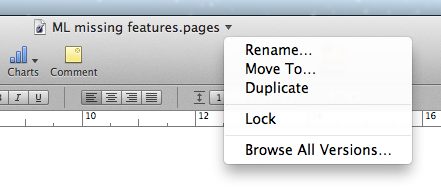Antoine de Saint-Exupéry once wrote, "perfection is finally attained not when there is no longer anything to add, but when there is no longer anything to take away." To make sure perfection doesn't slip through its fingers, Apple always errs on the side of taking away a bit more than some people think is necessary. Although Mountain Lion doesn't ruthlessly excise big-ticket items the way Lion did—such as compatibility with PowerPC binaries—there are still many smaller features that have gone away. After living with Mountain Lion for a few weeks, we're really starting to miss some of these. Here are 10 of the ones we miss the most:
11. X11. We haven't missed it. And we'd use XQuartz if we did.
10. Non-smooth scrolling. Much to John Siracusa's chagrin, there's no longer an option to turn off smooth scrolling system-wide. Yes, it looks pretty, but smooth scrolling also wastes time and activates our "something is moving in the grass!" instinct. It's still possible to scroll choppily by clicking inside the scroll bar—if present. There's also the option of using option or command+option and an arrow key, as in Safari Reader (for instance). In addition, John mentions a terminal command in his Mountain Lion review to disable smooth scrolling system-wide.
9. Automatic document locking. Lion would lock documents after 14 days to avoid inadvertent changes. Apparently someone at Apple got (understandably) annoyed with that big "this document is locked" message that appears after you start typing in a document you just opened, because Mountain Lion no longer has this feature. Although the warning could be startling, having some protection against inadvertent changes wasn't always a bad thing. Fortunately, you can still manually lock files from the Finder using the Get Info option, or with a little menu that drops down from the file's name in the title bar when you hover the pointer over it (in conforming applications).

8. IT writer Andrew Cunningham only needs one word: iChat. Yes, iChat's functionality has been subsumed into Messages. And sending iMessages from the desktop is pretty cool. But sometimes you just want to instant message using one of the "legacy" IM services, without all the other OS X and iOS devices in the house chiming in. There is a lot to be said for keeping IM and iMessage/SMS text messaging separate—they're just not the same thing. But there's nothing to be said for having video chat over IM in Messages and video chat through Apple's FaceTime in a separate app now that both are out of beta.
7. (The GUI to) Web sharing. OS X comes with a copy of Apache, the world's most popular Web server software. I've often used the built-in Web server to share files with my colleagues without the need to set up accounts and passwords. Apache is still there, and on my system—which had Web sharing enabled before I upgraded—it's still running. But it no longer knows how to locate HTML pages and files in the Sites folder of each user. And you can no longer turn it on or off in the sharing pane of the System Preferences.
6. The Safari search box. Contributing writer Jonathan Gitlin doesn't care who knows it—he wants it back. Yes, we've all typed search queries in the URL bar or URLs in the search bar in the past. It's not that the unified bar is necessarily a bad thing, but is it really so much to ask to be able to bring back the separate search box by customizing Safari's toolbar? Especially because with search suggestions turned on (the default), your search engine of choice gets to see URLs as you type them in the unified bar. And the suggestions have top billing, above your own history and bookmarks. Then again, with search suggestions turned off, you get no search suggestions when you actually want to search. With a separate search box you can have both privacy (well, such as it is) and convenience. And there's that half a decade's worth of muscle memory, too.
5. Displays in the menu bar. In the PowerPC days, there was actually a function key dedicated to turning on and off the mirroring of a laptop's internal display on an external display. We lost that key a few years after the Intel transition, but the little display icon in the menu bar was the next best thing, allowing you to quickly turn mirroring on and off, and to switch display resolutions. In Mountain Lion, you have to fire up the System Preferences for this; the menu bar icon now only governs mirroring the display to an Apple TV.

It's understandable that Apple has made the choices for display resolutions less prominent now that the CRT days are over, as LCD displays have a single native resolution. But quick access to that display mirroring toggle can be a lifesaver when you find yourself on stage at a conference with your entire computing life projected on the big screen behind you and nothing on your laptop screen. Apple, maybe you could let us bind the display mirroring toggle to a key? Or perhaps open the display preferences through right-clicking the desktop, similar to changing the desktop background picture?
Update: it turns out that there is an undocumented keyboard shortcut to toggle mirroring: command-F1 (as long as the function keys are mapped to special functions rather than F1/F2/F3 et cetera).
4. Using a laptop with the lid open, but with just an external display active. Running with the lid open keeps a laptop a good deal cooler during number crunching, and I can't even remember the number of times I needed the built-in trackpad to enable Bluetooth so I could switch to the wireless mouse and keyboard. Yes, you can move the menu bar to the external screen and turn off the backlight on the internal screen if you want to work on just the external screen with the lid open. But this still allows the mouse pointer and windows to get lost on the other screen, and it wastes GPU capacity to draw the unused screen.
Before Lion, you could just hook up the external screen to a laptop with the lid closed, wake up the laptop, then open the lid, and the screen would remain inactive. As of Lion, the internal screen comes on when you open the lid. But there was a trick to avoid this: first sleep the display, then open the lid, then wake up the display. Unfortunately, this trick no longer works in Mountain Lion. We know that it's possible to have the lid open and the internal screen inactive. Why not give us the opportunity to use this configuration if we want to? And if possible, without jumping through weird hoops, please.
3. Battery time. No, I'm not talking about the reduced battery life that many Mountain Lion users are experiencing. In previous versions of Mac OS X, you could have the time remaining until the battery is empty (or full, when charging) displayed next to the battery icon in the menu bar. You guessed it: it's missing in Mountain Lion. Now you have to click on the battery icon to see it. Hoops. Jumping. We don't like it.
2. Creative Director Aurich Lawson misses Safari's Activity Viewer. With the Activity Viewer, you could easily see the size and location of all the HTML, scripts, and images that are part of a webpage, and whether they had loaded. No more. Viewing the HTML source of a page is now also gone from the View menu, but at least you can bring that one back as "view page source" by enabling the debug menu in Safari's preferences.
1. RSS in Safari (and Mail). I first discovered RSS through Safari. Rather than visit sites manually, I just subscribed to their RSS feeds right from the browser and was then able to peruse the aggregated feeds to see if any of them had published something worth reading. I believe almost everyone who uses RSS has long since moved on to Google Reader or a specialized RSS reading app, so it's no big deal that Apple removed RSS from Safari (and Mail), right? Wrong. Although I no longer use Safari to aggregate feeds, I still used Safari's RSS button a lot after landing on a random blog post through a link posted somewhere. That button would quickly give me the latest ten or 20 headlines to provide context to a post. Yes, blogs have archives. But I really do miss that RSS button.
Why, Apple? Why?
In many cases, it makes sense that a feature is removed. Keeping PowerPC compatibility around forever is unworkable; the only question is whether removing it with Lion was too early or not. Letting users get software like Flash, Java, and X11 directly from the company or group that maintains the software is a slight inconvenience to users, but allows for quicker turnaround on security issues and clearly separates responsibilities. Things like removing the option to automatically lock files and the disabling of smooth scrolling are probably because Apple no longer thinks they're useful, and they have a hard time imagining that someone else still might. And I'm sure there is a constant hunt for GUI elements and settings that can be removed to avoid cluttering up the system.
But some changes are just perplexing, and can seem punitive. Like the battery status: when I first noticed it, I thought, "That makes sense; they could never figure out how long it really takes to charge the battery." But the same flawed estimate is still there, along with an option to enable/disable showing a percentage. You just have to click to get it. This seems like a change for the sake of change, with no advantage for Apple or the user. Maybe it will all make sense when we read about it in Tim Cook's biography.
Still, all hope is not lost, as Apple sometimes brings back excised features in the following OS X version. A good example is the "Save As" that was removed from applications that adopt Lion's new document model, which is now back—albeit it with an unexpected side effect. So, tell us (and Apple) which abandoned feature you miss the most in the discussion thread, and maybe we'll get back one or two missing features when the next big cat arrives in a year or so. Still, it would be better if such features would be brought back from the dead in a point release. In the current system, OS X users have to perpetually live in a half-baked world, with every version of OS X missing some features that are available in both older and newer releases.
reader comments
182